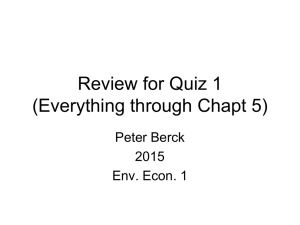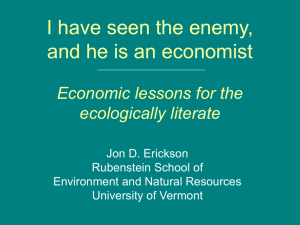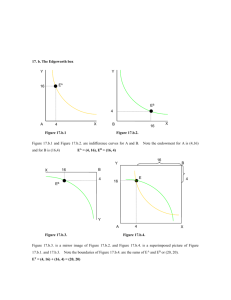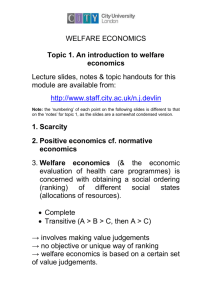Econ 350 Chapter02
advertisement
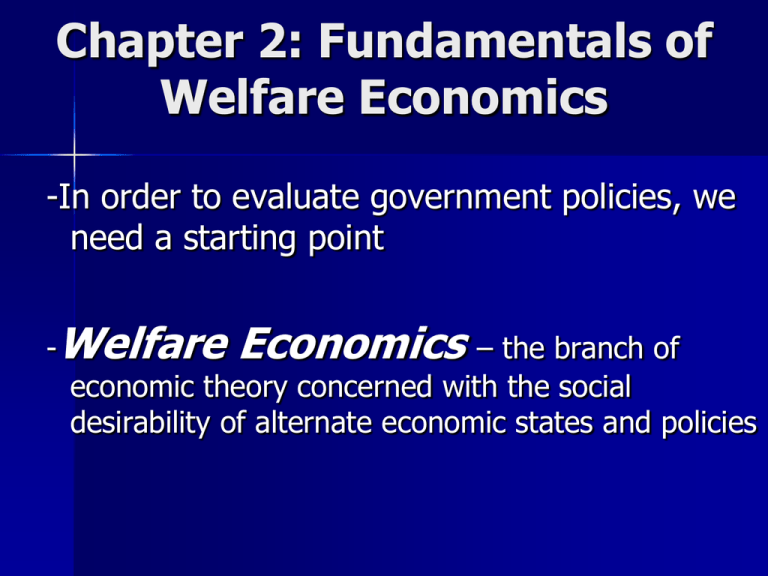
Chapter 2: Fundamentals of Welfare Economics -In order to evaluate government policies, we need a starting point -Welfare Economics – the branch of economic theory concerned with the social desirability of alternate economic states and policies Chapter 2: Fundamentals of Welfare Economics Welfare Economics First Fundamental Theorem of Welfare Economics Second Fundamental Theorem of Welfare Economics Theory - Starting Point: Pure Exchange Economy We start with a simple model: – 2 people – 2 goods, each of fixed quantity – Determine good allocation The important results of this simple, 2person model hold in more real-world cases of many people and many commodities 3 Pure Exchange Economy Example Two people: Maka and Susan Two goods: Food (f) & Video Games (V) We put Maka on the origin, with the y-axis representing food and the x axis representing video games If we connect a “flipped” graph of Susan’s goods, we get an EDGEWORTH BOX, where y is all the food available and x is all the video games: 4 Maka’s Goods Graph Food Ou is Maka’s food, and Ox is Maka’s Video Games u O Maka x Video Games 5 Edgeworth Box Food r y Susan O’ O’w is Susan’s food, and O’y is Susan’s Video Games Total food in the w market is Or(=O’s) and total Video Games is Os (=O’r) u O Maka x Video Games s Each point in the Edgeworth Box represents one possible good allocation 6 Edgeworth and utility We can then add INDIFFERENCE curves to Maka’s graph (each curve indicating all combinations of goods with the same utility) – Curves farther from O have a greater utility – (For a review of indifference curves, refer to Intermediate Microeconomics) We can then superimpose Susan’s utility curves – Curves farther from O’ have a greater utility 7 Maka’s Utility Curves Food Maka’s utility is greatest at M3 M3 M2 M1 O Maka Video Games 8 Edgeworth Box and Utility Susan O’ Susan has the highest utility at S3 r S1 Food S2 A At point A, Maka has utility of M3 and Susan has Utility of M3 S2 S3 M2 M1 O Maka s Video Games 9 Edgeworth Box and Utility Susan O’ If consumption is at A, Maka has utility M1 while Susan has utility S3 r Food A S3 O Maka B C Video Games By moving to point B and then point C, M3 Maka’s utility M2 increases while M1 Susan’s remains constant s 10 Pareto Efficiency Food r S3 O Maka C Susan O’ Point C, where the indifference curves barely touch is called PARETO EFFICIENT, as one person can’t be made better off M3 without harming the M2 other. M1 s Video Games 11 Pareto Efficiency When an allocation is NOT pareto efficient, it is wasteful (at least one person could be made better off) – Pareto efficiency evaluates the desirability of an allocation A PARETO IMPROVEMENT makes one person better off without making anyone else worth off (like the move from A to C) However, there may be more than one pareto improvement: 12 Pareto Efficiency Food r S3 S4 S5 A C E D O Maka Video Games Susan O’ If we start at point A: -C is a pareto improvement that makes Maka better off -D is a pareto improvement that M3 makes Susan better M2 off M1 -E is a pareto improvement that s makes both better off 13 The Contract Curve Assuming all possible starting points, we can find all possible pareto efficient points and join them to create a CONTRACT CURVE All along the contract curve, opposing indifferent curves are TANGENT to each other Since the slope of the indifference curve is the willingness to trade, or MARGINAL RATE OF SUBSTITUTION (x for y) (MRSxy), along this contract curve: Maka Susan MRSVf MRSVf Pareto Efficiency Condition 14 The Contract Curve Susan O’ Food r O Maka s Video Games 15 MATH – House and Chase Assume that house and Chase have the following utilities and MRS for books and coffee: U House MRS B C ,U House BC H H Chase B C C / B , MRS H H C Chase BC C C /B , C C The Pareto Efficiency Condition therefore becomes: MRS House BC MRS Chase BC C /B C /B H H C , C 16 MATH – House and Chase If there are 10 books, and 4 cups of coffee, then the contract curve is expressed as: MRS House BC MRS Chase BC , C / B (4 C ) /(10 B ) H H H H If House has 6 books, a pareto efficient allocation would be: H H C / 6 (4 C ) /(10 6) 4C 6(4 C ) H H 10C 24 H C 2.4 H 17 MATH – House and Chase Therefore, House would have 6 books and 2.4 cups of coffee, and Chase would have 4 (10-6) books and 1.6 (4-2.4) cups of coffee, for utilities of: U House B C U Chase B C 4(1.6) 2.52 H C H 6(2.4) 3.79 C 18 Theory - Starting Point: Economy with production A production economy can be analyzed using the PRODUCTION POSSIBILITIES CURVE/FRONTIER – The PPC shows all combinations of 2 goods that can be produced using available inputs – The slope of the PPC shows how much of one good must be sacrificed to produce more of the other good, or MARGINAL RATE OF TRANSFORMATION (x for y) (MRTxy) Note that although the slope is negative, the negative is assumed and rarely shown in simple calculations 19 Production Possibilities Curve Here the MRTSpr is equal to (75)/(2-1)=-2, or two robots must be given up for an extra pizza. 10 9 8 The marginal cost of the 3rd pizza, or MCp=2 robots Robots 7 6 The marginal cost of the 6th and 7th robots, or MCr=1 pizza 5 4 Therefore, MRTxy=MCx/MCy 3 2 Therefore, MRTpr=2/1=2 1 1 2 3 4 5 Pizzas 6 7 8 20 Efficiency and Production If production is possible in an economy, the Pareto efficiency condition becomes: MRTxy MRS PersonA xy MRS PersonB xy Assume MRTpr=3/4 and MRSpr=2/4. -Therefore Maka could get 3 more robots by transforming 4 pizzas -BUT Maka only needs to get 2 robots for 4 pizzas to maintain utility -Therefore his utility increases from the extra robot, Pareto efficiency isn’t achieved 21 Efficiency & Production Example From the PPC, we know that: MC x MRT xy MC y We can therefore reinterpret Pareto efficiency as: MC x PersonA PersonB MRS xy MRS xy MC y 22 Theory - First Fundamental Theorem Of Welfare Economics IF 1) All consumers and producers act as perfect competitors (no one has market power) and 2) A market exists for each and every commodity Then Resource allocation is Pareto Efficient 23 First Fundamental Theorem of Welfare Economics Origins From microeconomic consumer theory, we know that: P MRS x Py Since prices are the same for all people: MRS PersonA xy PersonA xy MRS PersonB xy Therefore economic theory gives us the first part of Pareto efficiency 24 First Fundamental Theorem of Welfare Economics Origins From basic economic theory, a perfect competitive firm produces where P=MC, therefore: MC P x MC y x Py But we know that MRT is the ratio of MC’s, therefore: P MRTxy x Py 25 First Fundamental Theorem of Welfare Economics Origins Again from microeconomic consumer theory, this changes to: MRT xy MRS xy Which satisfies the second requirement of Pareto Efficiency Therefore, we can expand Pareto Efficiency to imply that MC x Px PersonA PersonB MRT xy MRS xy MRS xy MC y Py 26 Efficiency≠Fairness If Pareto Efficiency was the only concern, competitive markets automatically achieve it and there would be very little need for government: – Government would exist to protect property rights Laws, Courts, and National Defense But Pareto Efficiency doesn’t consider distribution. One person could get all society’s resources while everyone else starves. This isn’t typically socially optimal. 27 Fairness Susan O’ r Food B O Maka C Points A and B are Pareto efficient, but either Susan or Maka get almost all society’s resources A Many would argue C is better for society, even though it is not Pareto s efficient Video Games 28 Fairness For each utility level of one person, there is a maximum utility of the other – Graphing each utility against the other gives us the UTILITY POSSIBILITIES CURVE Just as typical utility is a function of goods consumed: U=f(x,y), societal utility can be seen as a function of individual utilities: W=f(U1,U2) – This is referred to as the SOCIAL WELFARE FUNCTION, and can produce SOCIAL INDIFFERENCE CURVES: 29 Utility Possibilities Curve All points on the curve are Pareto efficient, while all points below the curve are not. Any point above the curve is unobtainable Maka’s Utility B O Maka C A Susan’s Utility 30 Typical Social Indifference Curves Maka’s Utility An indifference curve farther from the origin represents a higher level of social welfare. O Maka Susan’s Utility 31 Fairness If we superimpose social indifference curves on top of the utilities possibilities curve, we can find the Pareto efficient point that maximizes social welfare This leads us to the SECOND FUNDAMENTAL THEOREM OF WELFARE ECONOMICS 32 Maximizing Social Welfare ii is preferred to i, even though ii is not Pareto efficient Maka’s Utility i O Maka ii iii Susan’s Utility The highest possible social welfare, iii, is Pareto efficient 33 Second Fundamental Theorem of Welfare Economics The SECOND FUNDAMENTAL THEOREM OF WELFARE ECONOMICS states that society can attain any Pareto efficient allocation of resources by making a suitable assignments of original endowments, and then letting people trade -Roughly, by redistributing income, society can pick the starting point in the Edgeworth box, therefore obtaining a desired point on the Utility Possibility Frontier: 34 Second Fundamental Theorem of Welfare Economics Susan Food r O Maka O’ Starting Point Goal s Video Games 35 Why Income Redistribution? Why achieve equity through income redistribution instead of taxes/penalties and subsidies/incentives? Taxes and penalties punish incomeenhancing behavior, encouraging people to work less. Subsidies and incentives give an incentive to stay in a negative state to keep receiving subsidies and incentives. Lump sum transfers have the least distortion. 36 Why Is Government so Big? 1) Government has to ensure property laws are protected. (1st Theorem) 2) Government has to redistribute income to achieve equity. (2nd Theorem) 3) Often the assumptions of the First Welfare Theorem do not hold (Chapter 3) 37 Welfare Economics Limitations We Assume: Government exists to maximize the utility of its citizens. Government could aim to: Be a global power, achieve cultural goals, achieve religious goals, etc. Plus…what if people want to sit on the couch all day, watching the Biggest Loser? Should the government support this activity? 38 Merit Goods Merit Good – commodities that should be provided even if society a) doesn’t want them ie: police/fluorine in water And/Or b) is unwilling to cover their cost in the free market ie: Canadian Broadcast Corporation (CBC) 39 Welfare Economics Evaluation -Welfare Economics is concerned with RESULTS, not PROCESS -is the HOW important? -contract law? -Old Testament law? -Lottery? -Free-for-all wrestling match? 40 Welfare Economics Evaluation Welfare Economics asks 3 questions of every government action: 1) 2) 3) Will it have desirable distributional consequences? Will it enhance efficiency? Is the cost reasonable? -Although these questions may be difficult to answer, they provide direction, and if they are all “no”, the government shouldn’t interfere 41


